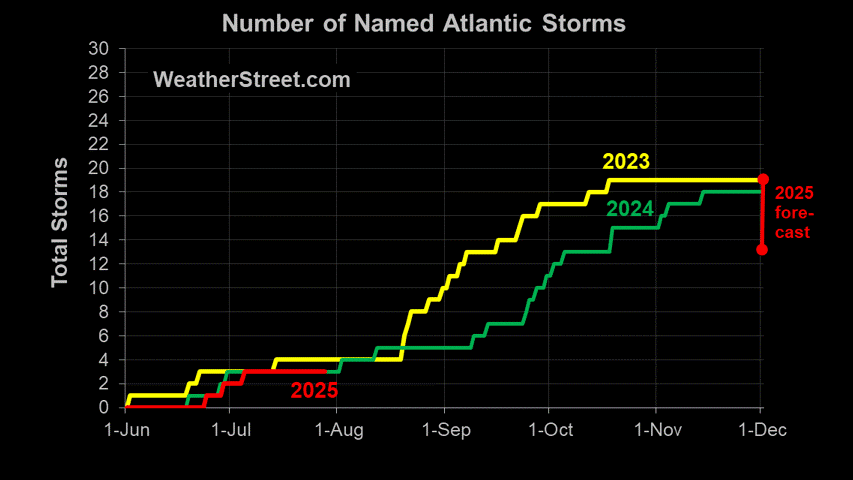Storm Alert issued at 23 Aug, 2009 21:00 GMT
Hurricane BILL is forecast to strike land to the following likelihood(s) at the given lead time(s):
Red Alert Country(s) or Province(s) Canada
probability for CAT 1 or above is 100% currently
probability for TS is 100% currently
St. Pierre and Miquelon
probability for CAT 1 or above is 55% within 9 hours
probability for TS is 100% within 9 hours
Red Alert City(s) and Town(s) Sydney (46.1 N, 60.1 W)
probability for CAT 1 or above is 90% within 9 hours
probability for TS is 100% currently
Yellow Alert Country(s) or Province(s) Scotland
probability for TS is 55% in about 69 hours
Ireland
probability for TS is 55% in about 69 hours
Northern Ireland
probability for TS is 55% in about 69 hours
Yellow Alert City(s) and Town(s) Grand Falls (48.6 N, 55.4 W)
probability for CAT 1 or above is 10% within 9 hours
probability for TS is 100% within 9 hours
St John's (47.6 N, 52.7 W)
probability for TS is 100% within 9 hours
Halifax (44.6 N, 63.6 W)
probability for TS is 75% currently
Charlottetown (46.2 N, 63.1 W)
probability for TS is 70% currently
Ullapool (58.0 N, 5.2 W)
probability for TS is 55% in about 69 hours
Portree (57.5 N, 6.2 W)
probability for TS is 55% in about 69 hours
Inverness (57.3 N, 4.3 W)
probability for TS is 55% in about 69 hours
Oban (56.3 N, 5.5 W)
probability for TS is 55% in about 69 hours
Glasgow (55.9 N, 4.3 W)
probability for TS is 55% in about 69 hours
Stranraer (55.0 N, 5.0 W)
probability for TS is 55% in about 69 hours
Ardara (54.8 N, 8.4 W)
probability for TS is 55% in about 69 hours
Belfast (54.6 N, 5.9 W)
probability for TS is 55% in about 69 hours
Sligo (54.3 N, 8.4 W)
probability for TS is 55% in about 69 hours
Belmullet (54.2 N, 10.0 W)
probability for TS is 55% in about 69 hours
Galway (53.3 N, 9.1 W)
probability for TS is 55% in about 69 hours
Dingle (52.2 N, 10.2 W)
probability for TS is 55% in about 69 hours
Green Alert Country(s) or Province(s) England
probability for TS is 50% in about 69 hours
the Isle of Man
probability for TS is 50% in about 69 hours
Wales
probability for TS is 45% in about 69 hours
Green Alert City(s) and Town(s) Stornoway (58.3 N, 6.4 W)
probability for TS is 50% in about 69 hours
Dundee (56.5 N, 3.0 W)
probability for TS is 50% in about 69 hours
Edinburgh (55.8 N, 3.1 W)
probability for TS is 50% in about 69 hours
Workington (54.6 N, 3.4 W)
probability for TS is 50% in about 69 hours
Dublin (53.3 N, 6.3 W)
probability for TS is 50% in about 69 hours
Bantry (51.7 N, 9.4 W)
probability for TS is 50% in about 69 hours
Wick (58.5 N, 3.1 W)
probability for TS is 45% in about 69 hours
Aberdeen (57.2 N, 2.1 W)
probability for TS is 45% in about 69 hours
Holyhead (53.3 N, 4.5 W)
probability for TS is 45% in about 69 hours
Cork (51.9 N, 8.5 W)
probability for TS is 45% in about 69 hours
Kirkwall (59.0 N, 3.0 W)
probability for TS is 40% in about 69 hours
Newcastle (55.0 N, 1.6 W)
probability for TS is 40% in about 69 hours
Wexford (52.3 N, 6.5 W)
probability for TS is 40% in about 69 hours
York (54.2 N, 1.5 W)
probability for TS is 35% in about 69 hours
Manchester (53.5 N, 2.3 W)
probability for TS is 35% in about 69 hours
Note that
Red Alert (Severe) is CAT 1 or above to between 31% and 100% probability.
Yellow Alert (Elevated) is CAT 1 or above to between 10% and 30% probability, or TS to above 50% probability.
Green Alert (Low) is TS to between 31% and 50% probability.
CAT 1 means Hurricane strength winds of at least 74 mph, 119 km/h or 64 knots 1-min sustained.
TS means Tropical Storm strength winds of at least 39 mph, 63 km/h or 34 knots 1-min sustained.
For graphical forecast information and further details please visit
http://www.tropicalstormrisk.com/ This alert is provided by Tropical Storm Risk (TSR) which is sponsored by UCL, Aon Benfield, Royal & SunAlliance, Crawford & Company and Aon Benfield UCL Hazard Research Centre. TSR acknowledges the support of the UK Met Office.















